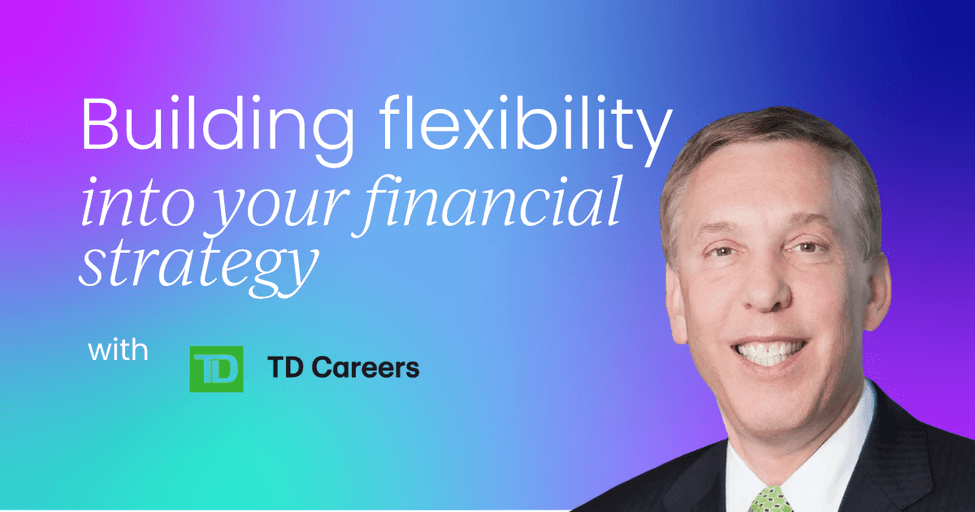[This article is based on a presentation given by William Fink, former Executive VP, Head of Middle Market Banking at TD, at our CFO Summit, Boston in 2024. Catch up on this presentation, and others, using our OnDemand service. And for more exclusive content, check out your membership dashboard.]
When we talk about planning for the unexpected, it’s tempting to jump straight into models, metrics, and tools. But before we go there, I want to start with something more fundamental - perspective.
In my role at TD Bank, leading U.S. Strategic Partnerships, I’ve had the opportunity to work with a wide range of businesses from small enterprises with $500,000 in revenue to major corporations north of $5 billion. I’ve seen strategy from the inside: through the lens of credit management, risk oversight, and the front lines of mergers, acquisitions, and growth. What I’ve learned is this - no two businesses face the same risks, but all of them must deal with uncertainty.
That’s why flexibility isn’t just a nice-to-have in financial strategy. It’s a necessity. Whether you're navigating market volatility, supply chain shocks, or the next big thing you didn't see coming, the ability to adapt is what separates resilience from reaction.
This isn’t about having all the answers. It’s about asking the right questions and building the frameworks, teams, and tools that allow you to respond when the unpredictable becomes reality. Let’s dive into how you can do that.
Topics covered:
- Scenario planning and risk management
- The role of AI in scenario planning
- Building collaborative teams for financial flexibility
- Preparing for unpredictable events
- The importance of contingency planning
- Stress testing and risk management
- Adapting to future unpredictability
- Scenario planning and business continuity
- Identifying growth opportunities amidst risks
- Differentiation without excess risk
Scenario planning and risk management
When it comes to managing uncertainty, there are two levers every CFO should have a firm grasp on: scenario planning and risk identification. And if I’m being honest, I could talk about this all day because it’s at the heart of the work I’ve done throughout my career.
Let’s start with scenario planning. Too often, it’s treated as a bolt-on or an isolated exercise, when in reality, it’s a core part of strategic planning. The best-run companies I’ve worked with (and I’ve seen thousands) have one thing in common: strong internal controls supported by dynamic, forward-looking strategic planning processes. And scenario planning sits right in the middle of that.
Over the past five years, contingency planning has become more prominent, and understandably so. Natural disasters, pandemics, supply chain breakdowns, geopolitical tensions... they’ve all made it clear: being reactive isn’t enough. Historically, contingency planning was focused mainly on recovery and how we bounce back. But today, it has to start with anticipation. That’s where scenario planning comes in.
And not just for the negative. Think back to the surges in demand for things like Pokémon cards, Cabbage Patch Kids, or even the Pet Rock. Entire supply chains got caught flat-footed. That’s positive disruption, and it's still a missed opportunity if you’re not ready for it.
So how do you build good scenario planning?
It doesn’t mean creating a hundred “what if” models. That’s not efficient. Instead, focus on three to five well-defined, realistic scenarios. Start by clarifying your objectives, understanding your key needs, and identifying where the biggest risks lie. Challenge your assumptions continuously. That’s what gives the process its power.
Depending on your business, you might use advanced modeling tools like Monte Carlo simulations or Oracle Crystal Ball. For high-risk industries like aerospace, nuclear, or defense, etc., you may run out six, even eight standard deviations. But not every business needs that level of rigor. The sophistication of your scenario planning should match the risk you’re managing.
That leads us directly into risk. The classic categories still hold true - strategic, operational, financial, legal, compliance, people, macroeconomic, and reputational. What’s changed is how frequently and how deeply they intersect.
Once you identify the types of risk, assess both the likelihood and the impact. Some risks are high-frequency but low-impact, you plan for those differently than a “black swan” event. In fact, I’d even add a fourth tier of risk above high: catastrophic. These are the ones that could end the business. Rare? Yes. But if you're not at least planning around them, you're leaving the door wide open.
Now, I’ll share something a bit controversial. Years ago, at Stanford’s risk management program, I heard Dr. Ron Howard (who coined the term “decision analysis”) say something I’ve never forgotten. He said, "There’s no such thing as a black swan event."
His argument? It’s not that the event is unprecedented, it’s that we failed to anticipate it. COVID-19 wasn’t the first pandemic. The financial crisis wasn’t the first market collapse. We just didn’t frame our planning well enough.
You may agree or disagree with that view, and that’s okay. But it brings us back to the same conclusion: scenario planning is about preparing for what’s plausible, even if it’s uncomfortable. It’s about building financial strategies that hold up not just in expected environments, but in the ones we’d rather not think about.

The role of AI in scenario planning
Let’s talk about tools, specifically AI and machine learning, and how they fit into scenario planning and risk management. Because there’s no question: the tools we have today are more powerful, more sophisticated, and more accessible than ever before. But we’re still just scratching the surface of what they can do.
Even before the explosion of AI, we had machine learning and it’s been around for a couple of decades. Yet, many organizations haven’t fully leveraged its capabilities. So as much as the buzz around AI is valid, the bigger question is: what are we doing with the tools we already have?
It starts with understanding what you’re solving for. You can’t let technology drive the strategy. The strategy has to guide the tech. That means clearly defining your objectives, understanding what risks you’re trying to monitor or anticipate, and then identifying the right data to support those goals.
Because here’s the truth: data for data’s sake is useless. You can be overwhelmed with so much raw information that you lose sight of what really matters. The old phrase comes to mind - you can’t see the forest for the trees.
What you want is not just data, but information - refined, structured, and relevant. Information that supports decision-making. Whether that’s a go/no-go on an investment, a shift in working capital strategy, or a tactical move to scale up inventory in response to demand. Data should be a driver, not a distraction.
And yes, AI can significantly enhance your ability to identify, quantify, and respond to risk. Whether it's flagging changes in customer payment behavior, monitoring macroeconomic shifts, or detecting patterns in operational performance, AI tools are quickly becoming essential. But they are only as effective as the data you feed them and the clarity of the decisions you want them to support.
Data management, then, becomes just as critical as the analytical models themselves. If you're not investing in clean, accessible, well-governed data structures, even the best tools won't help you move faster or smarter.
Building collaborative teams for financial flexibility
One of the most common questions I get (and it’s as old as business itself) is how do you actually get teams to work together across the organization? Especially when you’re trying to build financial flexibility in the face of real risk.
Let me tell you, it’s not magic. It’s structure. And most of all, it’s culture.
At TD, I worked across both the commercial and investment banking sides of the business. That intersection only functions when people collaborate. And true collaboration doesn’t happen without alignment - alignment of purpose, incentives, and leadership.
It starts at the top. Always. If the senior leadership team isn’t explicitly setting the tone that working cross-functionally is expected, valued, and measured, it won’t happen consistently. A middle manager deciding that collaboration is important won’t carry enough weight across silos. There will be skepticism. People won’t fully buy in. Culture has to be modeled and reinforced from the top down.



 Follow us on LinkedIn
Follow us on LinkedIn




